Owls: Welcome Guests to Your Yard
By Carolyn R. Casey, Fairfax Master Gardener
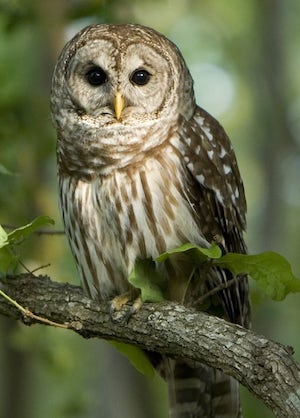
Barred Owl
Sometime ago, we had an unexpected visitor to our Certified Wildlife Habitat property who also helped reduce our unwanted rodent and reptile populations. What a sight to see and hear! Perhaps this season you may be visited by one of the species of Virginia owls who live in our beautiful state or those that are merely passing through, much like the hikers on the Appalachian Trail.
Did you know that there are over 220 owl species in the world that can be found on all continents except Antarctica? They have been given the nickname “ghost birds.” They have comb-like feathers on their large wings that allow for their quiet flights and stealthy approaches.
Most people do not have the opportunity to observe owls but have heard their familiar call. Owls have calls that range from hoots, hisses, howls, wails, to yowls and screams. The Romans believed that owls were a warning that a death was going to occur, while to the Greeks, owls predicted a military victory.
They have extraordinary adaptations that allow them to detect the exact location that a sound is coming from using their asymmetrical ears. The owls’ exceptional hearing allows them to detect prey that is moving quietly on the ground or a mouse that is digging under 2 feet of snow.
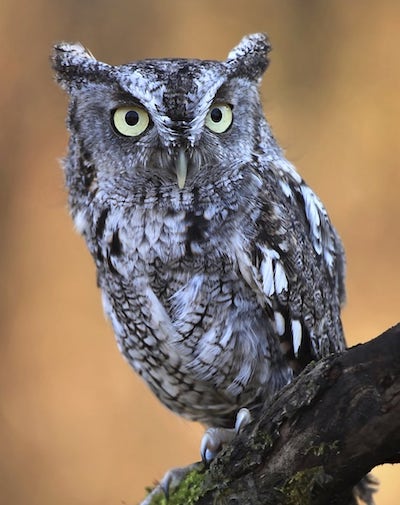
Eastern Screech Owl
Owls have large immobile tube-shaped eyes that face frontward and enable them to view faraway objects. They have a whitish or translucent membrane that creates an inner eyelid protecting the eye from dust and keeping it moist. This is known as the nictitating membrane. Owls have the ability to turn their heads 270 degrees so that they are able to observe from either side of the head.
Owls have very well developed leg and foot bones that are used to come to rest firmly on their prey. They have very sharp and curved talons that are used to grab a hold of and grasp their victims. Owls are zygodactyl, which means their feet have two forward-facing toes and two backward-facing toes. Owls can pivot one of their back toes forward to help them grip and walk.
Owls are carnivores and their diet consists of mice, shrews, voles, small birds and even snakes. Their beaks are curved down so that they can shred large prey apart and then swallow pieces and take these to their nesting owlets. They swallow their pray whole and then regurgitate the bones and feathers that they are unable to digest. This undigested material is known as a pellet.
There are four different owl species that nest year round in Virginia. They are the eastern screech owl, barn owl, barred owl and the great horned owl. Eastern screech owls, Megascops asio, are common owls seen in Virginia, even though they are not easily seen, since they are 8.5 inches (21 cm) tall and weigh about 6 ounces 170 g). Their plumage is reddish brown or gray. This makes it difficult to see them since they blend in with tree bark and the hollows of trunks where they make their nests. During the spring when the eastern screech owls are pairing up, they make a call that sounds like a horse whinnying. It is estimated that 60 percent of the eastern screech owl population are red, while 40 percent are gray.
Barn owls, Tyto alba, have white heart-shaped faces and the nickname “monkey owl.” They weigh about 1 pound and are 16 inches tall. Barn owls have white undersides with long legs. Their calls range from a barking sound to hisses or a clicking trill. Barn owls hunt over open fields. According to Cornell University’s All About Birds, “The barn owl has excellent low-light vision and can easily find prey at night by sight. But its ability to locate prey by sound alone is the best of any animal that has ever been tested. It can catch mice in complete darkness in the lab or hidden by vegetation or snow out in the real world.”
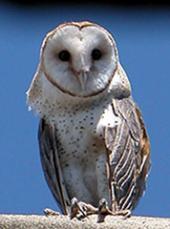
Barn Owl
Barn owls are usually found in Orange and Culpeper counties of Virginia. While some nest in hollow trees or in river banks like the ones that nest at the Rappahannock River’s Fones Cliffs, the majority of them are dependent on structures like barns, abandoned buildings, church steeples, bridges and tunnels to make their nests. Barn owls are listed as a Tier 3 Species of Greatest Conservation Need by Be Wild, Virginia! due to their declining population. They usually mate between April and early May and produce four to six young each year. They can have young at any time of year.
Barred owls, Strix varia, are definitely more easily heard than seen. They got their name from the “bars” or striped plumage that they have. They are a little over 1 pound (0.5 kg) and about 21 inches tall (50 cm). Their call sounds as if someone is saying, “Who cooks for you all?” While they primarily hunt at night, they can be seen during the daytime. They are usually found in old forests and are adaptable to many different habitats. “Barred owls are the opportunists of the owl world,” wrote Leigh Calvez in The Hidden Lives of Owls.
While out bird watching, I have observed barred owls at some of the canal locks in Maryland. They were very active flying back and forth with mice to feed their young chicks that were living in a hole in a tree. I have also had a barred owl that for several years would visit my backyard, observed catching and eating snakes. It was a treat to see the barred owl come down on a snake and spread its wings open to keep the snake from getting away and then consuming it.
Great horned owls, Budo virginianus, got their name from the tufts of feathers on their heads that look like horns. They have a very intimidating stare and distinct hooting call. They are large owls and weigh about 3 pounds (1.3 kg) and are about 22 inches (55 cm) tall. They have large yellow eyes, a white patch on their throats and are reddish brown, gray or black and white in color. Great horned owls like undisturbed habitats and forests. They also live in wetlands, grasslands and semi-open habitats. They have excellent night vision that allows them to be superb hunters. They are able to take down large prey like skunks, rabbits, snakes and even porcupines. They can also take down large raptors by knocking them out of a tree. They have a deadly grip that can sever the spine of their prey. Their nickname is “tigers of the sky.”
There are two owls that are known to be common winter residents that breed in Virginia but are only here part of the year. One is the short-eared owl and the other is the northern saw-whet owl.
Short-eared owls, Asio flammeus, are considered a rare find in Virginia. They have small ear tufts that are difficult to see. They also have heavy white streaking on their faces with yellow eyes that are outlined in black. They also have streaking on their brown and buff colored bodies. They weigh about 8 ounces and are 13 to 16 inches tall. They are usually seen outside of the breeding season. They have been seen at The University of Virginia’s Blandy Experimental Farm in Boyce, Tazewell, Culpeper and Orange counties in Virginia. They have also been seen at the Department of Game and Inland Fisheries Saxis Wildlife Management Area, located on the bayside of Virginia’s Eastern Shore in Accomack County. They like open areas such as marshes, meadows and fields, and they are seen hunting low to the ground in the daytime.
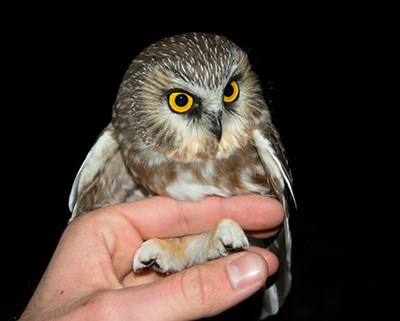
Northern Saw-whet Owl
Northern saw-whet owls, Aegolius acadicus, are Virginia’s smallest breeding owls. They are 7 to 8 inches (17-20 cm) tall and weigh about 2 to 5 ounces (50 to 140 g). They have bright yellow eyes and have a cat-like face. They are Virginia’s most mysterious owls. They are nocturnal and have the ability to elude being seen. Northern saw-whet owls got their name from the male who has a very shrill breeding call that sounds as if a saw blade is being sharpened on a whetstone. The Virginia’s Wildlife Action Plan lists them as a Tier 1, Species of Greatest Conservation Need. They are the most understudied bird in Virginia. Biologists have started a program where they are catching and banding the northern saw-whet owl. They are doing this to analyze their migration timing, differences in magnitude of flights among years, differences in timing and movement among age and sex classes.
Occasionally unique visitors will appear in Virginia. In 2015, the very secretive long-eared owl, Asio otus, was spotted at the Blandy Experimental Farm. It reappeared again in 2016 and 2017. Long-eared owls are about 14 inches tall (25 cm) and weigh about 7 to 15 ounces (200 to 400 g). They are nocturnal and pick roosts that are hard to find. Their population has decreased by an estimated 91 percent in North America since 1970. Over the last few years during the winter, there have also been sightings of the snowy owl, Bubo scandiacus.
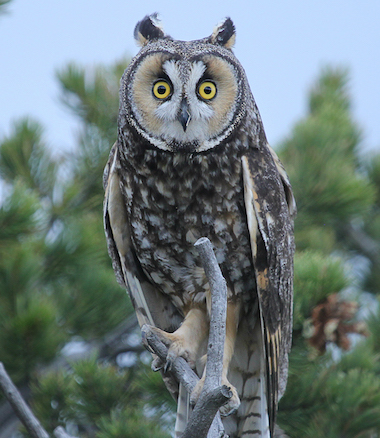
Long-eared Owl
The loss of habitat and human encroachment are the leading threats to owls. Meadow, fields and grasslands are disappearing, and these are the places where the primary food sources like mice, voles and small prey for owls live.
Owls can be injured or killed as they navigate the human-modified landscape. Many fly low over roadways or catch prey on roadsides, risking collisions with vehicles. Because they hunt at night, they are hard for drivers to see. Owls can also collide with fences and become tangled in the wire. They can also die from ingesting poisons used to kill rats, mice and other rodents. Some rodenticides can interfere with blood clotting and cause victims to bleed to death. At the Wildlife Center of Virginia, located in Waynesboro, Virginia, screech owls are the most common injured owl brought in. The center also cares for barred, barn and great horned owls. In 2017, of 1,208 intakes, 10 percent were owls.
When you are outside this year and you hear the call of an owl, may you be fortunate enough to not only hear the owl but to also be able to observe it in flight or resting in a nearby tree. Perhaps it will help eradicate some mice or unwanted reptiles in your garden. Happy Gardening!
Resources
The Hidden Lives of Owls, Leigh Calvez
13 Fun Facts About Owls, The National Audubon Society
Creating a Wild Backyard – Owls of Maryland, Maryland Department of Natural Resources
Virginia’s Most Mysterious Birds, Glenda C. Booth, Virginia Department of Wildlife Resources
Barn owl, Species of Greatest Conservation Need, Be Wild, Virginia!, Appendix A
All About Birds, Cornell University